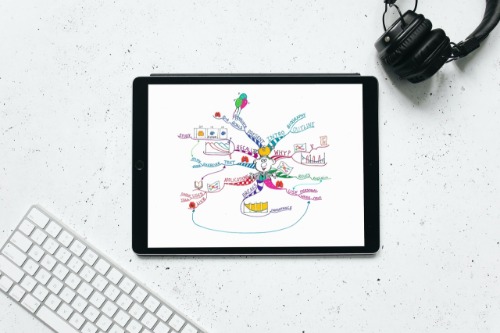Why Are Mind Maps Better Than Lists?
Mind Maps are so much more powerful than just considering them as an alternative to a list - but if I can be frank, this is often the jumping-off point for most people .. so let’s dive into this common question!
Why are Mind Maps better than a list? Mind Maps work because they reflect the way your brain loves to process and more importantly remember information. Mind Maps are firstly much more naturally memorable than a traditional list, so if you are prone to writing lists and then forgetting to take them with you then Mind Maps with memorable content may be a better strategy.
Better For Memory
We know that the first time we create information is the time when we are mostly likely to create a strong, accurate and long-lasting memory of that information. Part of creating truly memorable information is to create each session as uniquely outstanding as possible. Making it different every time, making it a “one of a kind” experience firmly rooted in our memory is the desirable outcome.

True Mind Maps start with a unique Central Image in full colour as the launch point. Each Central Image is chosen to be completely different to any other and to reflect the creators immediate association to the issue at hand - encoding this information much stronger than a generic, same format, same colour, same as-the-last-twenty-lists created linear list!
Novelty is important in learning - the human brain is naturally curious and easily bored. Mind Maps help to keep every experience fresh, exciting, new and different!
Better For Clarity of Thinking
Mind Maps reflect on paper the internal thought processes of the human brain. We think radiantly and creatively not in straight logical lines.
Capturing your radiant thinking quickly on a free-flowing Mind Map where you incorporate multiple images and connections helps you explore and refine your thinking on the subject without the restriction of “logically” following on from the last point on a linear list. As a new idea, thought or concept occurs to you it can be recorded in the right location of your Mind Map by a single keyword or image. Taking random flowing associations and creating clarity of thought and process.

A single image improves recall of the key items in a significantly better way. In the 1970s Ralph Haber concluded that recognition of images was 85-95% better than simply words alone. So get doodling!
Mind Maps in this way help you structure and clarify your associations and thoughts in a better way than a simple list.
Better For Time Management
Have you ever had the experience of writing a list and then realising that you have missed a point and need to squeeze it in between lines or scribble it into the margin with a connecting arrow?
Lists soon become messy and complicated to navigate with information sandwiched in here and there. The solution is often to write and rewrite the information until it can all be presented in a “neat and tidy way” in monochromatic colours in a linear offering.

Mind Maps enable you to organise from the centre out - from the principal concept you ripple out through main themes, important points and out to the details. There is space on a Mind Map to add additional information at any point without the necessity of a complete rewrite.
Mind Maps may be exuberantly colourful and free-flowing but they are inherently logical in their radiant hierarchy. You read clockwise from 12 o’clock and from the middle to the periphery exploring not only the width of the subject but its depth.
These first ”in the moment” Mind Maps should rarely be rewritten as the Primacy Effect states that the most effective time to remember new information is the first time you come across it - the “in the moment” Mind Map, therefore, becomes the most powerful mnemonic tool and to waste time in writing and rewriting it would serve only to dilute its power.
Better For Kids Learning to Organise
Children experience the world through all of their senses .. they touch, taste, smell, hear and see the world in glorious imagination-rich and memorable technicolour … until we restrict their worlds to long lists of black words on white paper.
I have witnessed first-hand young students stressed and tearful because a list has “gone wrong” and it no longer looks “neat and tidy” for a teacher. I have also witnessed them blossom and bloom when using Mind Maps to demonstrate the incredible learning and insights they have without the stress of a list-making technique that works contrary to their wonderfully creative brains.

Instead of trying to corral our children into arbitrary and Victorian strictures of what “learning” - or at least “learning by rote” looks like on paper why not encourage our children to demonstrate their genius and diversity by showing the connections, the imagination, the width and depth of their thinking on a Mind Map?
The good news is that research from the 1990s supports the theory that children remember more from content on a Mind Map than that presented in a linear form - showing a 32% improvement in recall.
Less stress, more real learning .. another way that Mind Maps are better than a list!
Better For Those Who Struggle To Process
Within any group of people, there is a wide range of learning abilities and preferred learning styles .. in learning I’m afraid “One size does not fit all”.
You would think that understanding this that the process of sharing information would be built around how the brain loves to learn and acquire information instead of restricting it to a series of “this is how we have always done it” methodologies.
The human race has a long and distinguished history of being able to pass on masses of life-critical information prior to the rather recent invention of the printing press and subsequent increase in literacy. Our brains are truly remarkable with as yet no limit established as to what the human brain, when fed information in the way it loves to process, can hold.
And yet, those who struggle to learn in the narrow structures of “the way we do it here” can often feel disenfranchised and excluded.

Mind Maps enable students to demonstrate the granularity of the knowledge they have instead of merely their aptitude in learning by rote a list of information provided and repeating that list.
Imagine - to demonstrate what is actually known instead of what can merely be regurgitated in one form, regardless of whether reading, writing, organisation or global processing is the issue being managed.
Mind Maps are better than lists for demonstrating the connectivity and expansiveness of knowledge acquired regardless of the different learning styles or challenges.
Better For The Professional
So much better for the professional who has to learn to juggle many different priorities, projects and obligations within their working hours.

Mind Maps beat lists when they permit the outcome of any point not to be merely a Yes or No - but multiple choices of outcomes depending on the situation at hand.
Mind Maps - unlike lists give both context and structure, juggling many variables and alternatives before moving to clarity and decision making with a great understanding of the global concept.
Mind Maps - unlike your humble list, enable both a focus on the Big Picture of a piece of planning or a project, integrating many lists into one Mind Map with the obvious benefit of saving both time and money in deleting duplication and redundancy.
Mind Maps can become a shared resource - displayed and shared among all stakeholders who can easily see why decisions are being made in relation the overall global plan and their part in delivering a successful outcome.
Mind Maps allow for engagement at the appropriate layer of granularity depending on specific roles. An executive may be happy with the Mind Maps 20,000 ft overview whilst the production line needs to understand the detail and minutiae of the deliverables of a project.
Having one document that spec’s out the whole project is an inclusive practice that also helps to clarify why certain operational and planning decisions have been arrived at, saving time, money, and friction. Simple lists for each role do not have the same cohesive outcome.
Detailed Mind Maps also help to refine not only the “How” things should be done but “why” they should be executed too.
Lastly “no plan survives first contact with the enemy” - in today's fast-changing business environment a more flexible, fluid, and adaptable way of planning is needed. Rather than a quickly outdated list of tasks to be accomplished, a fluid and more organic planning structure that can react quickly to changes in the business environment may be preferable.
Better Long Term Payoff
So - why are Mind Maps better than lists? Lists for sure can be quick to create but they are slow to adapt. The list can be effective at recording but score poorly in understanding and recall.
Mind Maps may take slightly longer in the first instance to create but the long tail benefits of greater understanding, comprehension, recall, creativity, flexibility and clarity far outweigh the humble traditional list-making method in many ways.
So - for your humble shopping list .. create a traditional list by all means .. but don’t forget and leave it lying on top of the kitchen table when you leave or you may wish that you had created something more memorable instead!
.png)


